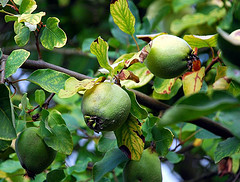Quince
| Infobox on Quince | |
|---|---|
| Example of Quince |  |
| Freshness facts | |
| Optimum carrying temperature | -0,5°C to 0°C |
| Highest freezing point | -2,0°C |
| Acceptable product temp. at loading into containers | Max. 2°C above carrying temperature |
| Optimum humidity | 90% to 95% |
| Ventilation setting for containers | 25 m³/hr |
| Storage life | 2 to 3 months |
| Climacteric / non-climacteric | Climacteric |
| Ethylene production | Low |
| Ethylene sensitivity | High |
| Modified / controlled atmosphere | There is no recommendation for CA storage |
| Potential benefits | - |
| Availability | |
| Australia South America (Chile) |
May - July April - May |
Quince
Contents
Harvesting and Handling
Quince is a many-seeded pome, pyriform type of fruit. Properly ripened quince are used for jellies, marmalades, preserves and to some extent for baking, canning, and adding flavour to other processed fruit products. Harvest begins when fruit change their ground colour from deep-green to a lighter green.
Green, immature fruit scalds readily in storage and fruit affected with scab does not store well. Since fruit are rather tender and bruise easily, the packaging box should be lined with soft pads on both ends. The blossom end is turned upwards rather than the stem end. Fruit should be handled carefully to avoid mechanical injury.
Cooling and Storage
Optimum storage temperature is -0,5°C to 0°C with about 90% RH. Storage-life in air at -0,5°C is 2 to 3 months, similar to early apple cultivars, such as 'Jonathan' and 'Grimes Golden'. The best ripening temperature for quince fruit after storage is 20°C. Since quince is a climacteric fruit, the acceleration of ethylene production during ripening may be expected.
Cautions
There is no recommendation for CA storage.
Storage disorders
Bacterial rot. Quince is subject to decays similar to those found on apples and pears. Treatment with fungicides is necessary to prevent decay during storage and marketing.











